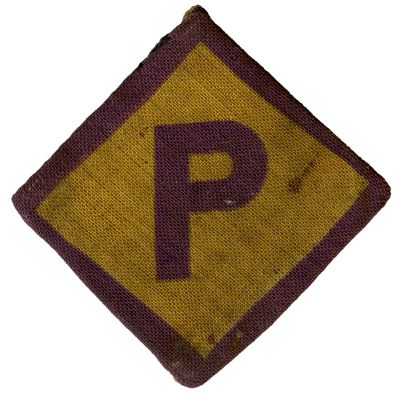The letter „P“

The Nazis were obsessed with the idea of categorising people according to various criteria, primarily according to race. That said it was difficult to assign many people to a category according to their appearance. In order to ensure that people could be recognised as “inferior” within this absurd, perfidious and finally tragic system of racist segregation, a number of different insignia were introduced soon after the beginning of the war. Starting in autumn 1939 Jews were forced to wear a yellow Star of David in the occupied areas; and from 1941 onwards in the area of the Reich. A badge with the letter ‘P’ was introduced for Polish forced labourers in March 1940. The forced labourers– and these included a huge number of Poles – who were moved into the Reich from the newly occupied areas after the invasion of the Soviet Union were forced to wear a piece of cloth with the white word “Ost” (East) on a blue background. Concentration camps also had their own elaborate rules for categorising prisoners.
Whereas the Jewish population in the area of the Reich were rapidly forced out of public life, deported and exterminated, and the number of yellow Stars of David sank accordingly, the number of badges with the letter P rose in millions as people from Polish areas were brought to the West to replace male workers in agricultural and industrial regions who had been sent to fight and die at the front. All in all during the Second World War around 2,800,000 Poles worked within the borders of the Reich, of whom around 95% were recruited by force.
The categorisation of Poles was regulated by the so-called “Polish Edicts” of 8th March 1940 and by several other related orders. The wording read: “From the first day of work we must ensure that Polish workers will be recognised as such at any time and by everyone. The badges are exclusively there to serve this necessity. There is no intention to defame these people thereby.” But this was of course exactly what was intended. The badge, according to a police regulation was to be “always worn in a visible manner… on the right-hand side of the chest”. It consisted “of a 5 cm square standing on one of its corners with a 2½ cm violet P against a yellow background on a half centimetre wide violet border.” The highly unusual choice of colour and shape was supposedly meant to avoid any association with Polish national symbols. The “Petka“, as the badge was known to the Poles, stigmatised the forced labourers in public. This explains why they continually tried to conceal it beneath the lapels of their jackets outside their places of work, or attempted to remove it completely. Such attempts might end disastrously. Zbyszko Matuszewski remembers: “Heaven help you if you forgot your P. The first time you had to pay a penalty of 10 Marks. And the second time even more. And after they caught you a few more times you were dispatched to a penal colony. No, they didn’t catch me so often. I only had to pay penalties.” Indeed at the end of 1941 the following decree was issued :“(…) Anyone who is caught on more than one occasion without a P badge [is to be] taken to the state police headquarters for further treatment.” What “further treatment” actually meant remained vague, but it could indicate the worst possible treatment. Nonetheless there was still a great temptation to go out onto the streets without the ‘P’, even perhaps – and this was forbidden like so many other things – to go to the cinema. “We girls mostly concealed our ‘P’s“ said Irina G.
![Poster "P" of the Volksbund für das Deutschtum im Ausland Poster "P" of the Volksbund für das Deutschtum im Ausland - Collection Porta Polonica [from BPK]](/sites/default/files/styles/width_100_tiles/public/assets/images/plakat_p.jpg?itok=3tWI7KyG)





